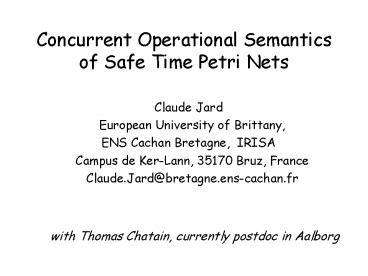Concurrent Operational Semantics of Safe Time Petri Nets PowerPoint PPT Presentation
Title: Concurrent Operational Semantics of Safe Time Petri Nets
1
Concurrent Operational Semantics of Safe Time
Petri Nets
- Claude Jard
- European University of Brittany,
- ENS Cachan Bretagne, IRISA
- Campus de Ker-Lann, 35170 Bruz, France
- Claude.Jard_at_bretagne.ens-cachan.fr
with Thomas Chatain, currently postdoc in Aalborg
2
Time Concurrent Semantics
- Seems to be a bit contradictory
- Time is a global notion
- Concurrency is implied by independent actions,
which are locally decided - Is difficult
- even for the simple case of safe time Petri net,
the definition of unfoldings and finite complete
prefixes was left open
3
What we have done
Safe Time Petri Net
Its finite complete prefix
- Ingredients
- Mixed of graphical and symbolic constraints
- Duplication of events to capture different
temporal constraints for a same event - Introduction of reads arcs
4
Time Petri Nets Merlin 1976
- Syntax ltP,T, pre, post, efd, lfd, M0gt
- Sequential semantics
- Global state (M,dob,?)
- (M,dob,?) -t-gt (M,dob,?) iff
5
Firing Sequences
0
0
- (p1p2,00,0)
6
Firing Sequences
0
1.3
- (p1p2,00,0) -t2-gt (p1p4,01.3,1.3)
7
Firing Sequences
0
3
1.3
- (p1p2,00,0) -t2-gt (p1p4,01.3,1.3) -t1-gt
(p3p4,31.3,3)
8
Firing Sequences
3
3
3
1.3
- (p1p2,00,0) -t2-gt (p1p4,01.3,1.3) -t1-gt
(p3p4,31.3,3) - -t0-gt (p1p2,33,3)
9
Firing Sequences
3
3
3
1.3
- (p1p2,00,0) -t2-gt (p1p4,01.3,1.3) -t1-gt
(p3p4,31.3,3) - -t0-gt (p1p2,33,3) -t1-gt (p2p3,33,3)
10
Firing Sequences
3
3
3
5
- (p1p2,00,0) -t2-gt (p1p4,01.3,1.3) -t1-gt
(p3p4,31.3,3) - -t0-gt (p1p2,33,3) -t1-gt (p2p3,33,3)
- -t2-gt (p3p4,35,5)
11
Firing Sequences
3
3
5
3
5
- (p1p2,00,0) -t2-gt (p1p4,01.3,1.3) -t1-gt
(p3p4,31.3,3) - -t0-gt (p1p2,33,3) -t1-gt (p2p3,33,3)
- -t2-gt (p3p4,35,5) -t3-gt (p4p5,55,5)
12
Symbolic Firing Sequences
- (p1p2,00,0) -t2-gt (p1p4,0?1,?1) -t1-gt (p3p4,
?2?1,?2) - -t0-gt (p1p2,?3?3,?3) -t1-gt (p2p3,?3?4,?4)
- -t2-gt (p3p4,?4?5,?5) -t3-gt (p4p5,?5?6,?6)
- where 1?12?0?2?max(?2,?1)?3max(?2,?1)?
- ?3?22??32?4??31?5?32??5?42?
- ?6?42??6max(?4,?5)
13
Time processes
- First attempt Aura, Lilius 1997
- Time processes are those of the underlying
(untimed) Petri net that are consistently dated - Can be defined inductively from the firing
sequences
14
(No Transcript)
15
t2(1.3)
16
t2(1.3) t1(3)
17
t2(1.3) t1(3) t0(3)
18
t2(1.3) t1(3) t0(3) t1(3)
19
t2(1.3) t1(3) t0(3) t1(3) t2(3)
20
t2(1.3) t1(3) t0(3) t1(3) t2(3) t3(5)
21
Unfolding
- Defined as the superimposition (union) of all the
time processes (share the common prefixes)
t2(1.3) t1(3) t0(3) t1(3) t2(3) t3(5)
t1(1) t3(3)
22
Unfolding
- Defined as the superimposition (union) of all the
time processes (share the common prefixes)
23
Problem with the symbolic representation
- Consider the processes built from the sequences
- t1(?1).t3(?3) and t1(?1).t2(?2).t3(?3)
- Constraints on t3 are
- ?12 ? ?3?12 (first case)
- ?12 ? 1?22 ? ?2?12 ? ?3?12 ?
?3max(?1,?2) - The superimposition will provide a disjunction,
which will make difficult the extraction of
processes in the general case - Except for the particular case of Time Extended
Free Choice Nets
24
- Event duplication
- Introduction of read arcs
- (to preserve concurrency)
- Efficient concurrent
- semantics by considering
- local firing rules
25
Local States
- Assume a partition (Pi) in mutually exclusive
places (simplifies the test of token absence)
(p?Pi, p Pi \ p) - p1,p3,p5,p2,p4,p6 in our example
- A maximal (partial) marking is a set of places
with one place per each subset of the partition - A local state is ltL, dob, lrdgt (lrd stands for
latest reading date)
_
26
Local Enabling
To minimize the number of read arcs
- )
_
27
Local Firing Rule
- (M, dob, lrd) -t,?,L-gt (M, dob, lrd)
28
(Extended) Time Processes
29
t2(1.3,p2)
30
t2(1.3,p2) t1(3,p1)
31
t2(1.3,p2) t1(3,p1) t0(3,p3p4)
32
t2(1.3,p2) t1(3,p1) t0(3,p3p4) t1(3,p1)
33
t2(1.3,p2) t1(3,p1) t0(3,p3p4) t1(3,p1) t2(3,p2)
34
t2(1.3,p2) t1(3,p1) t0(3,p3p4) t1(3,p1) t2(3,p2)
t3(5,p3p4)
35
Unfolding
- Defined as the union of all the time processes
- Properties
- Unfolding of Time Extended Free Choice Nets is
the standard unfolding - Unfolding of Time Nets limited to 0,? is the
untimed usual unfolding - The unfolding of disconnected nets remains
disconnected
36
Process extraction
37
Complete Finite Prefixes
- Two maximal states are considered equivalent if
they have - the same marking and the same reduced ages in
the places - The set of expressions defining the reduced ages
in the maximal - states of the processes is finite
- Prefixes are computed incrementally provided a
substitution in the - firing date expressions
38
Substitution
39
Conclusion
- An original notion of unfolding of Time PN and
its finite representation - Tries to code the maximum of concurrency in the
graphical part - Complexity issues are to be worked
- Other models? (non-safe, networks of Timed
Automata, local semantics of time)

